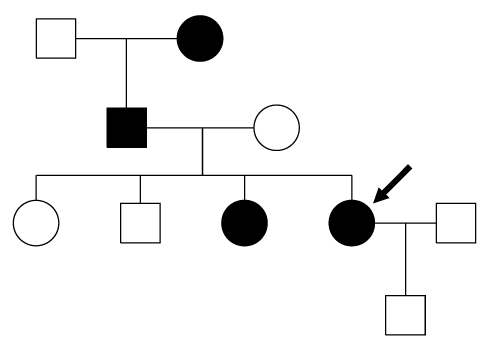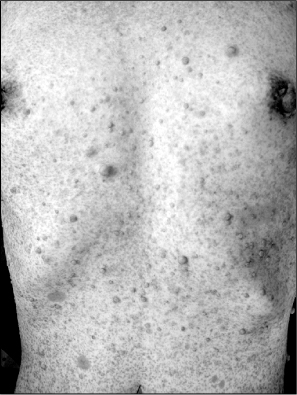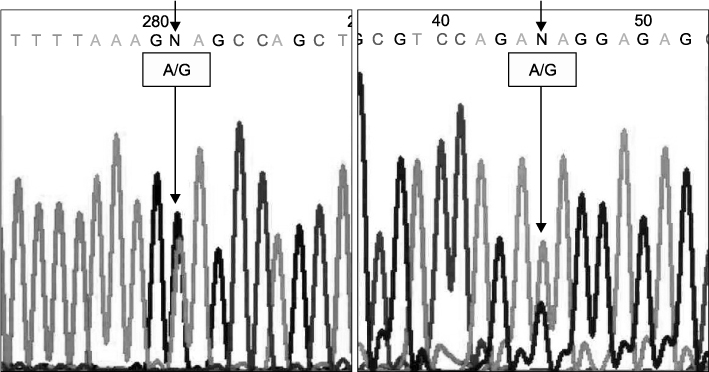J Korean Surg Soc.
2009 Jun;76(6):388-391. 10.4174/jkss.2009.76.6.388.
Bilateral Metachronous Breast Cancer in Neurofibromatosis Type 1
- Affiliations
-
- 1Department of Surgery, Dankook University College of Medicine, Cheonan, Korea. changmc@dankook.ac.kr
- KMID: 1464956
- DOI: http://doi.org/10.4174/jkss.2009.76.6.388
Abstract
- Neurofibromatosis type 1 (NF1) is an autosomal dominant disease, characterized by cafe-au-lait spot, axillary and inguinal freckle, peripheral neurofibroma and pigmented iris hamartoma. The various cancer incidences are increased in the NF1. But NF1 with breast cancer is rare. In this report we present a case of a 46-year-old NF1 female with a bilateral metachronous breast cancer. The patient has no BRCA2 mutation, but there are two unclassified variants in the exon 11 of BRCA1. The possibility of LOH of BRCA1 gene in the cancer tissue cannot be excluded.
Keyword
MeSH Terms
Figure
Reference
-
1. Kim BG, Kim JJ, Cho JS, Park UC. Malignant metachronous cancers (breast cancer, small bowel leiomyosarcoma) associated with von Recklinghausen disease (NF 1). J Korean Surg Soc. 1999. 56:300–305.2. Lee HJ, Chun YS, Lee NJ, Lee HS, Kim TH, Yoon HK, et al. Breast cancer in three women associated with von Recklinghausen's disease. J Korean Surg Soc. 2008. 74:217–221.3. Sorensen SA, Mulvihill JJ, Nielsen A. Long-term follow-up of von Recklinghausen neurofibromatosis. Survival and malignant neoplasms. N Engl J Med. 1986. 314:1010–1015.4. Brasfield RD, Das Gupta TK. Von Recklinghausen's disease: a clinicopathological study. Ann Surg. 1972. 175:86–104.5. Rasmussen SA, Yang Q, Friedman JM. Mortality in neurofibromatosis 1: an analysis using U.S. death certificates. Am J Hum Genet. 2001. 68:1110–1118.6. Nakamura M, Tangoku A, Kusanagi H, Oka M, Suzuki T. Breast cancer associated with Recklinghausen's disease: report of a case. Nippon Geka Hokan. 1998. 67:3–9.7. Yaegashi S, Sachse R, Ohuchi N, Mori S, Sekiya T. Low incidence of a nucleotide sequence alteration of the neurofibromatosis 2 gene in human breast cancers. Jpn J Cancer Res. 1995. 86:929–933.8. Ogata H, Sato H, Takatsuka J, De Luca LM. Human breast cancer MDA-MB-231 cells fail to express the neurofibromin protein, lack its type I mRNA isoform and show accumulation of P-MAPK and activated Ras. Cancer Lett. 2001. 172:159–164.9. Guran S, Safali M. A case of neurofibromatosis and breast cancer: loss of heterozygosity of NF1 in breast cancer. Cancer Genet Cytogenet. 2005. 156:86–88.10. Ceccaroni M, Genuardi M, Legge F, Lucci-Cordisco E, Carrara S, D'Amico F, et al. BRCA1-related malignancies in a family presenting with von Recklinghausen's disease. Gynecol Oncol. 2002. 86:375–378.
- Full Text Links
- Actions
-
Cited
- CITED
-
- Close
- Share
- Similar articles
-
- Bilateral breast carcinoma
- Bilateral Metachronous Breast Cancer with Bilateral Recurrences: A Case Report and Literature Review
- Clinical review of bilateral breast cancer
- Malignant Metachronous Cancers (Breast Cancer, Small Bowel Leiomyosarcoma) Associated with Von Recklinghausen Disease (NF 1)
- Bilateral Breast Cancer




